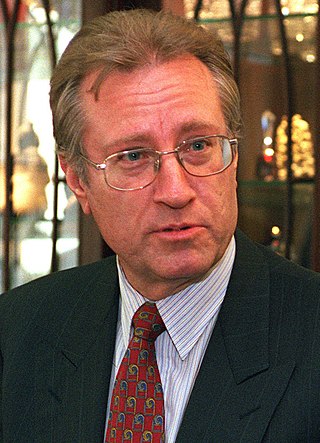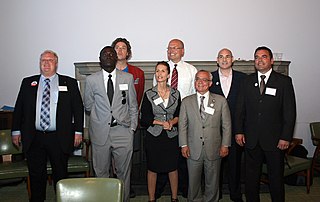NAPLPS is a graphics language for use originally with videotex and teletext services. NAPLPS was developed from the Telidon system developed in Canada, with a small number of additions from AT&T Corporation. The basics of NAPLPS were later used as the basis for several other microcomputer-based graphics systems.

Telidon was a videotex/teletext service developed by the Canadian Communications Research Centre (CRC) during the late 1970s and supported by commercial enterprises led by Infomart in the early 1980s. The CRC referred to Telidon as a "second generation" system, offering improved performance, 2D colour graphics, multilingual support and a number of different interactivity options supported on various hardware. With additional features added by AT&T Corporation, and 16 other contributors in North America and supported by the Federal Government, Telidon was redefined as a protocol and became the NAPLPS standard.

Videotex was one of the earliest implementations of an end-user information system. From the late 1970s to early 2010s, it was used to deliver information to a user in computer-like format, typically to be displayed on a television or a dumb terminal.

Canada's contemporary theatre reflects a rich diversity of regional and cultural identities. Since the late 1960s, there has been a concerted effort to develop the voice of the 'Canadian playwright', which is reflected in the nationally focused programming of many of the country's theatres. Within this 'Canadian voice' are a plurality of perspectives - that of the First Nations, new immigrants, French Canadians, sexual minorities, etc. - and a multitude of theatre companies have been created to specifically service and support these voices.

Queen Street is a major east–west thoroughfare in Toronto, Ontario, Canada. It extends from Roncesvalles Avenue and King Street in the west to Victoria Park Avenue in the east. Queen Street was the cartographic baseline for the original east–west avenues of Toronto's and York County's grid pattern of major roads. The western section of Queen is a centre for Canadian broadcasting, music, fashion, performance, and the visual arts. Over the past twenty-five years, Queen West has become an international arts centre and a tourist attraction in Toronto.

Arthur C. Eggleton is a retired Canadian politician who served as the 59th and longest-serving mayor of Toronto from 1980 to 1991. He was elected to Parliament in 1993, running as a Liberal in York Centre and served as a member of Parliament (MP) until 2004 when he declined to seek re-election. Eggleton held a number of cabinet positions from 1993 to 2002 including Treasury Board president, minister of infrastructure, minister of international trade, and minister of national defence. He was appointed to the Senate in 2005, serving until he reached the mandatory retirement age of 75 in 2018.

Trinity Bellwoods Park is a public park located in Toronto, Ontario, Canada, bordered by Queen Street West on the south and Dundas Street on the north. The western boundary of the park is Crawford Street, several hundred feet before Crawford intersects with Dundas St. West, the park juts toward Shaw Street, westside of the Crawford Street Bridge. Most of the park's area lies in the original Garrison Creek ravine and this creek, now a buried city storm sewer, still flows beneath the park from the northwest to the southeast corners.
Anne Johnston was a Canadian politician and community activist. She was a longtime city councillor in Toronto, Ontario, Canada. She was first elected to Toronto City Council in 1972, and served until 1985 when she ran against incumbent Mayor Art Eggleton, but was defeated. In 1988 she was elected to Metro Toronto Council. She served until Toronto was amalgamated into the megacity in 1997. That year, she was elected to the new Toronto City Council and served until 2003, when she was defeated by Karen Stintz. At the time of her defeat, she was the longest-serving and the oldest member of Toronto council.

General Idea was a collective of three Canadian artists, Felix Partz, Jorge Zontal and AA Bronson, who were active from 1967 to 1994. As pioneers of early conceptual and media-based art, their collaboration became a model for artist-initiated activities and continues to be a prominent influence on subsequent generations of artists.

The Cameron House is a small bar, live music venue, and informal cultural centre located on Queen Street West, just west of Spadina Avenue, in the city's downtown core of Toronto, Ontario, Canada. The Cameron has a front lounge and a back room, both with the capacity for audiences of no more than sixty people. It has been described as a Toronto crossover of CBGB's and the Chelsea Hotel in New York.
InterAccess is a Canadian artist-run centre and electronic media production facility in Toronto. In August of1981, Bill Perry and Ric Amis started "Telidon at Trinity Square Video", with a "Norpak Telidon Information Provider System" given to Bill by Bell Canada. The project was so popular, within 18 months, Bill Perry, Nina Beveridge and Geoffrey secured operational funding and premises to establish a separate, artist run organization called Toronto Community Videotex, incorporated in March of 1983. The founding directors were Bill Perry, Nina Beveridge, Geoffrey Shea and Paul Petro. Known today as InterAccess, it is Ontario's only exhibition space devoted exclusively to technological media arts. The Centre for Contemporary Canadian Art places the founding of InterAccess as a key moment in both the history of Canadian electronic art but also within a timeline of developments in international art, science, technology and culture.
The 1982 Toronto municipal election was held on November 8, 1982, in Metropolitan Toronto, Ontario, Canada. Mayors, controllers, city councillors and school board trustees were elected in the municipalities of Toronto, York, East York, North York, Etobicoke and Scarborough.

Keith Cole is a queer Canadian performance artist and political activist. Originally from Thunder Bay, Ontario, he is currently based in Toronto, Ontario. An alumnus of York University's Fine Arts program, Cole has worked in film and video, dance and theatre performance, both as himself and in character as drag queen Pepper Highway.
Michael John Hollingsworth is a Canadian playwright, theatre director and experimental multimedia artist. He is best known for The History of the Village of the Small Huts, a series of 21 historical plays dramatizing and satirizing Canadian history.
Jordan Tannahill is a Canadian author, playwright, filmmaker, and theatre director.
Kim Katrin is a Canadian American writer, multidisciplinary artist, activist, consultant, and educator. She was formerly credited as Kim Crosby and Kim Katrin Milan. She speaks on panels and keynotes conferences nationally, and facilitates radical community dialogues. Her art, activism and writing has been recognized nationally.
Nell Tenhaaf is a Canadian artist, teacher, writer and feminist.
Maria Torrence Wishart was a Canadian medical illustrator and the founder of the University of Toronto's Art as Applied to Medicine program. She was educated at Johns Hopkins School of Medicine under Max Brödel, and in 1925 returned to Canada to found the Department of Medical Art Service in the Faculty of Medicine.

The Clichettes were an all-women feminist performance art group formed in Toronto, Canada in 1977. Their practice is notable for injecting humour and theatricality into the sphere of performance art. The three performers initially worked using lip sync and choreography as their tools to parody pop culture depictions of femininity and later expanded their practice by including elements from science fiction and theatre in their performances. The Clichettes are notable for their impact on Canadian performance art as well as Feminist and performing arts in general.
Cliff Cardinal is a Cree and Lakota actor and playwright from Toronto, Ontario, most noted for his one-man show The Land Acknowledgement, or As You Like It.









